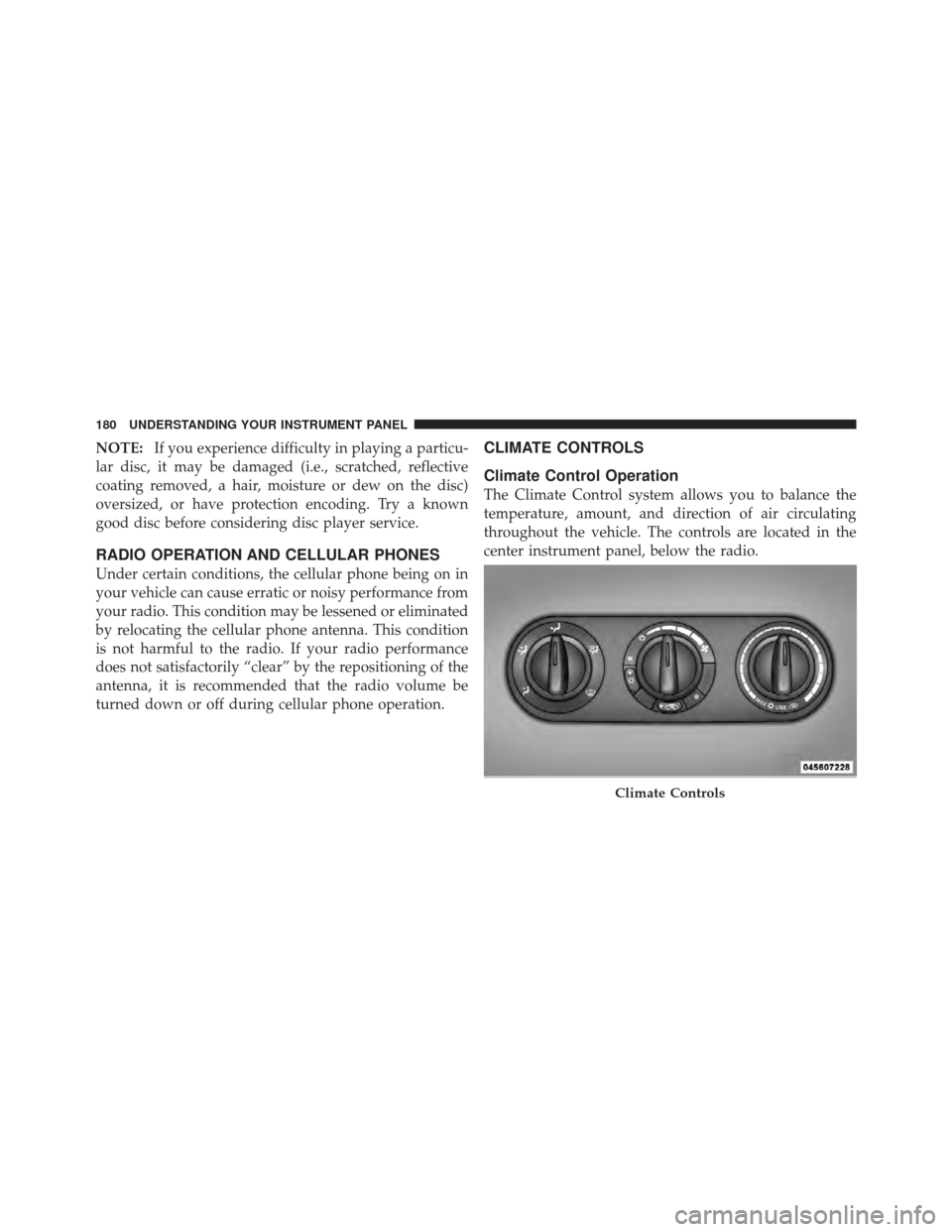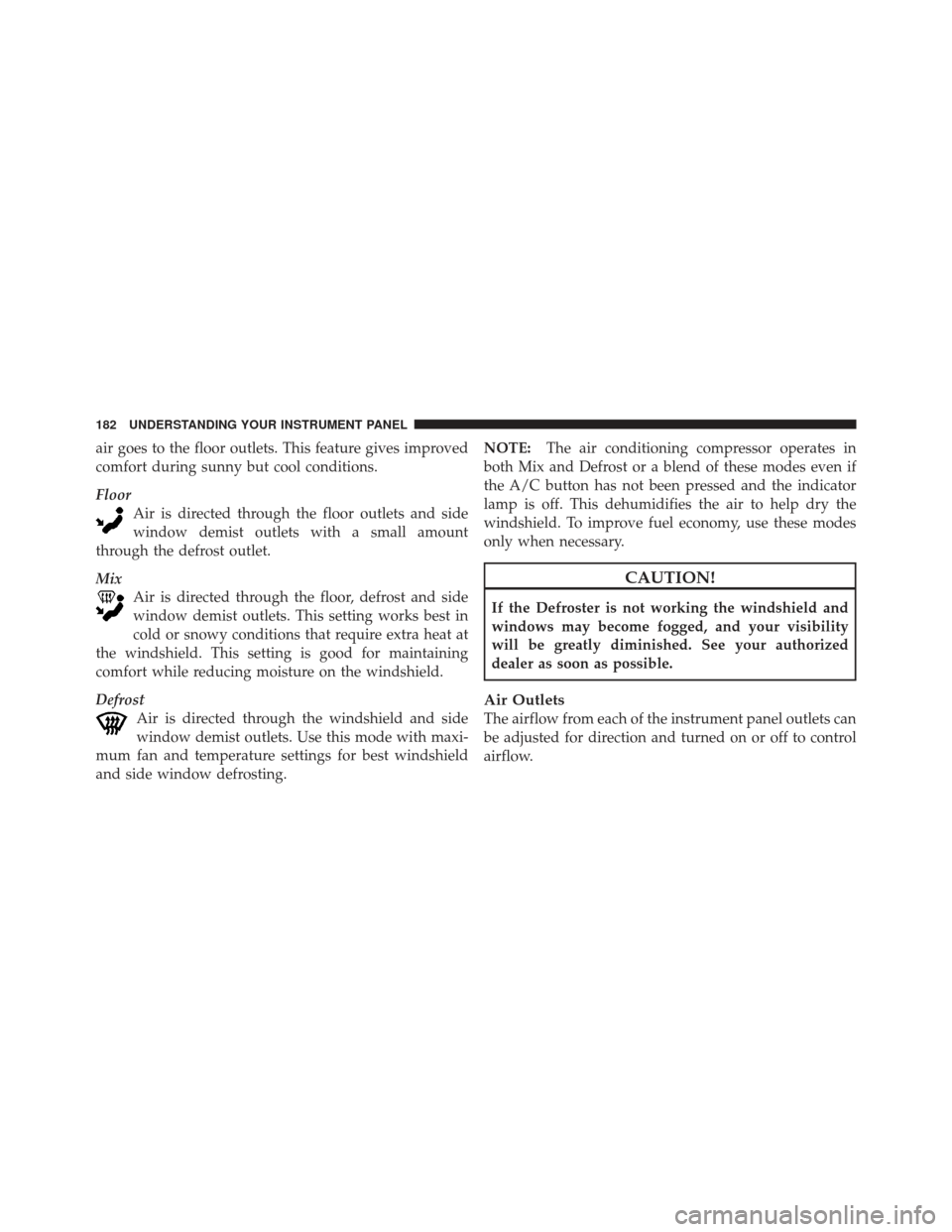2010 CHRYSLER PT CRUISER air condition
[x] Cancel search: air conditionPage 26 of 368

General Information
This device complies with Part 15 of the FCC rules and
RSS 210 of Industry Canada. Operation is subject to the
following conditions:
•This device may not cause harmful interference.
•This device must accept any interference received,
including interference that may cause undesired
operation.
NOTE: Changes or modifications not expressly ap-
proved by the party responsible for compliance could
void the user’s authority to operate the equipment. If your RKE transmitter fails to operate from a normal
distance, check for these two conditions:
1. A weak battery in the transmitter. The expected life of
the battery is a minimum of three years.
2. Closeness to a radio transmitter such as a radio station
tower, airport transmitter, and some mobile or CB radios.
Transmitter Battery Replacement
NOTE:Perchlorate Material – special handling may ap-
ply. See www.dtsc.ca.gov/hazardouswaste/perchlorate.
The recommended replacement battery is CR2032.
2
THINGS TO KNOW BEFORE STARTING YOUR VEHICLE 25
Page 76 of 368

inspect the exhaust system each time the vehicle is raised
for lubrication or oil change. Replace as required.
Safety Checks You Should Make Inside the
Vehicle
Seat Belts
Inspect the belt system periodically, checking for cuts,
frays, and loose parts. Damaged parts must be replaced
immediately. Do not disassemble or modify the system.
Front seat belt assemblies must be replaced after a
collision. Rear seat belt assemblies must be replaced after
a collision if they have been damaged (i.e., bent retractor,
torn webbing, etc.). If there is any question regarding belt
or retractor condition, replace the belt.
Airbag Warning Light
The light should come on and remain on for four to eight
seconds as a bulb check when the ignition switch is first
turned ON. If the light is not lit during starting, see yourauthorized dealer. If the light stays on, flickers, or comes
on while driving, have the system checked by an autho-
rized dealer.
Defroster
Check operation by selecting the defrost mode and place
the blower control on high speed. You should be able to
feel the air directed against the windshield. See your
authorized dealer for service if your defroster is
inoperable.
Floor Mat Safety Information
Always use floor mats designed to fit the foot well of
your vehicle. Use only floor mats that leave the pedal
area unobstructed and that are firmly secured so that
they cannot slip out of position and interfere with the
pedals or impair safe operation of your vehicle in other
ways.
2
THINGS TO KNOW BEFORE STARTING YOUR VEHICLE 75
Page 144 of 368

INSTRUMENT CLUSTER DESCRIPTIONS
1. Fuel Gauge
When the ignition switch is in the ON position, the
pointer will show the level of fuel remaining in the fuel
tank.
2. Fuel Door Reminder
This is a reminder that the Fuel Filler Door is located on
the front passenger’s (right) side of the vehicle.
3. Temperature Gauge
The temperature gauge shows engine coolant tempera-
ture. Any reading within the normal range indicates that
the engine cooling system is operating satisfactorily.
The gauge pointer will likely indicate a higher tempera-
ture when driving in hot weather, up mountain grades,
or when towing a trailer. It should not be allowed to
exceed the upper limits of the normal operating range.
CAUTION!
Driving with a hot engine cooling system could
damage your vehicle. If temperature gauge reads “H”
pull over and stop the vehicle. Idle the vehicle with
the air conditioner turned off until the pointer drops
back into the normal range. If the pointer remains on
the “H” and you hear continuous chimes, turn the
engine off immediately, and call an authorized deal-
ership for service.
4
UNDERSTANDING YOUR INSTRUMENT PANEL 143
Page 181 of 368

NOTE:If you experience difficulty in playing a particu-
lar disc, it may be damaged (i.e., scratched, reflective
coating removed, a hair, moisture or dew on the disc)
oversized, or have protection encoding. Try a known
good disc before considering disc player service.
RADIO OPERATION AND CELLULAR PHONES
Under certain conditions, the cellular phone being on in
your vehicle can cause erratic or noisy performance from
your radio. This condition may be lessened or eliminated
by relocating the cellular phone antenna. This condition
is not harmful to the radio. If your radio performance
does not satisfactorily “clear” by the repositioning of the
antenna, it is recommended that the radio volume be
turned down or off during cellular phone operation.
CLIMATE CONTROLS
Climate Control Operation
The Climate Control system allows you to balance the
temperature, amount, and direction of air circulating
throughout the vehicle. The controls are located in the
center instrument panel, below the radio.
Climate Controls
180 UNDERSTANDING YOUR INSTRUMENT PANEL
Page 182 of 368

NOTE:The air conditioning system of your vehicle
contains R-134a, a refrigerant that does not deplete the
ozone layer in the upper atmosphere.
The controls are as follows:
Fan Control
Use the Fan control to regulate the
amount of air forced through the sys-
tem in any mode you select. The fan
speed increases as you move the con-
trol to the right from the off position.
NOTE: For vehicles equipped with Remote Start, the
climate controls will not function during Remote Start
operation if the fan control is left in the “O” (off) position.
Mode Control (Air Direction)
The Mode control allows you to
choose from several patterns of air
distribution. You can select either a
primary mode, as identified by the
symbols, or a blend of two of these
modes. The closer the control is to a
particular mode, the more air distribu-
tion you receive from that mode
Panel Air is directed through the outlets in the instrument
panel. These outlets can be adjusted to direct airflow.
Bi-Level Air is directed through the panel and floor outlets.
NOTE: There is a difference in temperature between the
upper and lower outlets for added comfort. The warmer
4
UNDERSTANDING YOUR INSTRUMENT PANEL 181
Page 183 of 368

air goes to the floor outlets. This feature gives improved
comfort during sunny but cool conditions.
FloorAir is directed through the floor outlets and side
window demist outlets with a small amount
through the defrost outlet.
Mix Air is directed through the floor, defrost and side
window demist outlets. This setting works best in
cold or snowy conditions that require extra heat at
the windshield. This setting is good for maintaining
comfort while reducing moisture on the windshield.
Defrost Air is directed through the windshield and side
window demist outlets. Use this mode with maxi-
mum fan and temperature settings for best windshield
and side window defrosting. NOTE:
The air conditioning compressor operates in
both Mix and Defrost or a blend of these modes even if
the A/C button has not been pressed and the indicator
lamp is off. This dehumidifies the air to help dry the
windshield. To improve fuel economy, use these modes
only when necessary.
CAUTION!
If the Defroster is not working the windshield and
windows may become fogged, and your visibility
will be greatly diminished. See your authorized
dealer as soon as possible.
Air Outlets
The airflow from each of the instrument panel outlets can
be adjusted for direction and turned on or off to control
airflow.
182 UNDERSTANDING YOUR INSTRUMENT PANEL
Page 184 of 368

NOTE:For maximum airflow to the rear seat passen-
gers, the center instrument panel outlets can be aimed, so
that the left center outlet is directed toward the right rear
passenger and the right center outlet is directed toward
the left rear passenger.
Temperature Control
Use this control to regulate the tem-
perature of the air inside the passenger
compartment. The blue area of the
scale indicates cooler temperatures
while the red area indicates warmer
temperatures.
NOTE: If your air conditioning performance seems
lower than expected, check the front of the A/C con-
denser (located in front of the radiator), for an accumu-
lation of dirt or insects. Clean with a gentle water spray
from behind the radiator and through the condenser. Fabric front fascia protectors may reduce airflow to the
condenser, reducing air conditioning performance.
Air Conditioning (A/C) — If Equipped
Press the A/C button to engage the air
conditioning. A lamp will illuminate
when the air conditioning system is
engaged
NOTE: The air conditioning compressor will not engage
until the engine has been running for about 10 seconds.
4
UNDERSTANDING YOUR INSTRUMENT PANEL 183
Page 212 of 368

WARNING! (Continued)
•The capabilities of an ABS-equipped vehicle must
never be exploited in a reckless or dangerous
manner that could jeopardize the user’s safety or
the safety of others.The ABS Telltale Light monitors the Anti-Lock
Brake System. The light will come on when the
ignition switch is turned to the ON position
and may stay on for as long as four seconds.
If the ABS light remains on or comes on while driving, it
indicates that the anti-lock portion of the brake system is
not functioning and that service is required. However,
the conventional brake system will continue to operate
normally if the “Brake Warning Light” is not on.
If the ABS light is on, the brake system should be serviced
as soon as possible to restore the benefits of anti-lock brakes. If the ABS light does not come on when the
ignition switch is turned to the ON position, have the
bulb repaired as soon as possible.
If both the “Brake Warning Light” and the “ABS Light”
remain on, the Anti-Lock Brake (ABS) and Electronic
Brake Force Distribution (EBD) Systems are not function-
ing properly. Immediate repair to the ABS system at an
authorized dealer is required.
When the vehicle is driven over 7 mph (11 km/h), you
may also hear a slight clicking sound as well as some
related motor noises. These noises are the system per-
forming its self-check cycle to ensure that the ABS system
is working properly. This self-check occurs each time the
vehicle is started and accelerated past 7 mph (11 km/h).
ABS is activated during braking under certain road or
stopping conditions. ABS-inducing conditions can in-
clude ice, snow, gravel, bumps, railroad tracks, loose
debris, or panic stops.
5
STARTING AND OPERATING 211